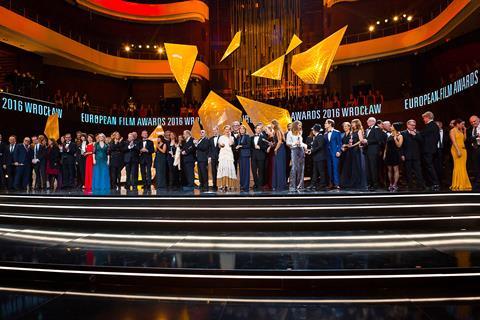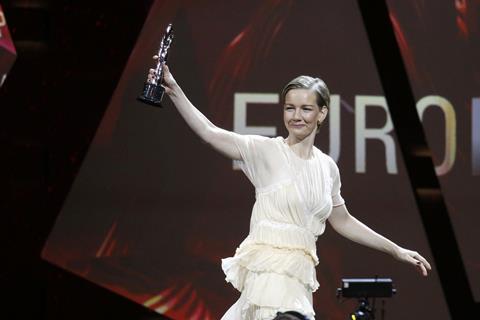With this year’s ceremony taking place in Berlin on December 9, Screen looks back at the European Film Awards’ evolution over the past three decades.

It all started over a bottle of white wine. Berlin’s senator for cultural affairs Volker Hassemer and Erika Gregor, co-founder of the Berlinale Forum, were reflecting on how they could give a greater profile to European cinema. Their deliberations subsequently triggered the proposal to stage a gala event celebrating cinema “made in Europe” in 1988, the year also designated by the European Union as European Cinema and Television Year.
“Originally, the idea was for the European Film Awards (EFAs) to be presented on just one occasion at the end of Berlin’s year as the European City of Culture in 1988,” says European Film Academy director Marion Döring, who has been involved in the awards’ organisation since the very first edition was held in Theater des Westens on November 26, 1988. “But when the filmmakers from east and west came together, they were so euphoric that such a common initiative had been possible that they decided to establish what would later become the European Film Academy.”
While the first edition was organised by the Berlin Senate as part of its City of Culture programme, the responsibility for staging future ceremonies was placed in the hands of the filmmakers gathered in the newly formed Academy — initially called the European Cinema Society and set up in 1989 under the auspices of 40 European filmmakers including inaugural president Ingmar Bergman and chairman Wim Wenders. As set out in the awards’ regulations, the EFAs’ remit is “to celebrate the excellence and diversity of European cinema, to attract new audiences to European film, and to draw attention to new European talent”.
Initially, the submission procedure was similar to that for the foreign-language film Oscar: each country had a committee that selected a national candidate, although the choices of films were arguably more often dictated by political considerations than artistic criteria. A selection jury then decided on the nominations, which were in turn viewed by a jury of Academy members in order to pick the winners. This procedure changed in 1996 when UK producer Nik Powell succeeded Wenders as EFA chairman and sought to introduce a more democratic system whereby all of the Academy’s membership (potentially) would have a say in the final winners as they now voted on the nominated films.
Swelling the ranks

Powell’s decision to encourage more producers and other filmmaking professionals to join the Academy’s ranks also had a positive knock-on effect on the awards, resulting in the range of prize categories gradually being extended to recognise the achievements of craftspeople including costume designers, editors, sound designers and hair and make-up artists.
Films can be submitted as candidates for the EFAs by European film institutions, festivals, trade magazines, media partners, EFA members, EFA patrons and producers of European films as long as the titles in question have had their official screening (either at a festival or in a regular cinema) between June 1 of the previous year and May 31 of the year of the awards ceremony. In the case of documentary titles, a film can also be eligible for submission if it has been screened at one of 10 leading European documentary festivals, including IDFA, CPH:DOX, Krakow Film Festival and Sheffield Doc/Fest.
Looking back at the EFAs’ 30-year history, it is clear that the organisers have adapted wherever possible to changing audience patterns and viewing habits. This is evidenced by the Young Audience Award (in its sixth edition this year) and the European University Film Award (EUFA) in collaboration with Filmfest Hamburg. The Young Audience Award began as a pilot project in May 2012, with youth audiences in six European cities watching three nominated films before voting for their favourite, which was announced at an awards ceremony the same day.
Since then, the number of cities and participating partner institutions has grown in leaps and bounds: the 2017 edition saw some 2,000 12- to 14-year-olds in 31 European countries from Portugal to Israel discussing the three nominated films before naming Fatih Akin’s Goodbye Berlin as their winner. Meanwhile, the EUFA is only in its second year, but the number of participating countries and universities has risen from 13 to 20 for the initiative, which was inspired by Quebec’s Prix collégial du cinéma québécois.
This year’s line-up of five nominated films included Icelandic coming-out drama Heartstone and documentary The War Show, with each university class choosing its favourite film before sending a representative for a three-day deliberation meeting in Hamburg at the beginning of December to decide the final winner. “These two initiatives are prime examples of what one can achieve to create a better awareness of European cinema and, in particular, among the next generation of cinema audiences,” Döring suggests. “It shows that one should place a greater emphasis on film education.”
Crossing cultures
However, reaching the general cinemagoing public via the People’s Choice Award is not as easy as it might seem due to the fragmentary nature of Europe’s distribution landscape. “We try to select films that have been shown in as many European countries as possible,” Döring says. “But it’s often difficult to find films that have all been seen by the people who are voting. With the Young Audience Award and EUFA, we know that the voters have seen them all.”
This year, film fans across Europe had nine titles to choose from as their favourite for the People’s Choice Award, including Bridget Jones’s Baby, Cristian Mungiu’s Graduation, Paolo Virzi’s Like Crazy, A Monster Calls, Frantz and Fantastic Beasts And Where To Find Them.
Changing television viewing habits and the advent of digital technology have also left their mark on the way the awards are promoted to the general public. While the first ceremony in 1988 was broadcast live by Eurovision and Intervision in a primetime slot, the organisers are faced with a different scenario three decades later. “With online streaming and social media, we are reaching a different audience and a much younger one, which is important for the European cinema,” Döring says. “And we now have a lot more going on at various levels on Facebook, Twitter and in blogs.”
As the EFAs approaches its 30th birthday, many professionals in the European film industry believe the event is still essentially one known only to insiders. “For sure, the EFAs helped films such as Ida or Youth sustain momentum for the Oscars, but I don’t see a great impact on audiences. People outside the industry are not familiar with this award,” says Jan Naszewski, CEO, acquisitions and sales, at New Europe Film Sales, while Susan Wendt, director of international sales and marketing at TrustNordisk, sees the awards “more as a tool and [form of] appreciation from a business-to-business perspective”, which “can provide that extra push to get a film sold in certain territories”.
“The EFAs should target the same emotions as the Oscars and Eurovision Song Contest,” suggests Ivan Hronec, CEO of the hybrid distribution platform Film Europe. “And to achieve this, we must unleash a positive spirit of national competition.” Distributor-producer Denis Ivanov of Ukraine’s Arthouse Traffic argues that “more stars should attend the ceremony to attract more attention from the general public”. At the same time, his company — which distributed last year’s big EFA winner Toni Erdmann and is also handling one of this year’s European Film nominees, On Body And Soul — spreads news to the Ukrainian media about the EFA nominations and ceremony as part of the promotional campaign for its releases.
“The award ceremony is not just about handing out prizes,” Döring concludes. “It is an opportunity to show commitment to Europe and the European idea as well as to the medium of cinema.”























No comments yet